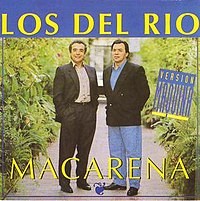Piano Sheets > Los Del Rio Sheet Music > Macarena (ver. 3) Piano Sheet
Macarena (ver. 3) by Los Del Rio - Piano Sheets and Free Sheet Music

About the Song
Other avaliable versions of this music sheet: Version 2 Version 3
"Macarena" is a Spanish song by Los del Ro with the help of Fangoria (band) about a woman of the same name, or any woman from the La Macarena neighborhood of Seville, Spain. It was popular between 1993 and 1997.
The song became the second longest running #1 and best selling debut single of all time in the U.S. It was ranked the "#1 Greatest One-Hit Wonder of all Time" by VH1 in 2002.
The song uses a type of clave.
The song ranks at #5 on Billboard's All Time Top 100. It also ranks at #1 on Billboard's All Time Latin Songs. Los del Ro (Spanish for Those from the River, referring to the Guadalquivir or the Guadaira) is a Spanish music duo composed of musicians Antonio Romero Monge and Rafael Ruz. They are originally from the city section of Dos Hermanas in Seville. As a duo, Romero and Ruiz have been a consistent, and persistent, act since the early 1960s. They had achieved considerable.
Download this sheet!
About the Artist

Random article
How to read sheet music How to read sheet music
Reading piano sheet music is no simple thing. For it first we require to know the individual elements of the composition itself in order to read sheet music. You must make sure that you are familiar with that particular composition's language before you tackle the entire piece.
In order to grasp the intent and nuances of the piece quickly for reading piano sheet music following steps are to be considered:-
1> To start with have a look over entire composition to get the feel of the length and style of the sheet music. This first run through is just to have a quick overview of the composer's work. This will slowly prepare you to read the sheet music.
(More...)
